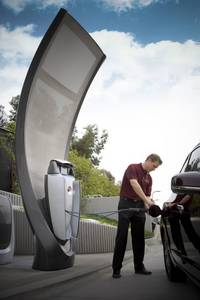American Honda Opens New Solar Hydrogen Station
TULLAMARINE, AUSTRALIA – January 29, 2010: American Honda has introduced a prototype next generation solar hydrogen station at Honda R&D Americas, Inc. The home refuelling station will be used to refill fuel cell electric vehicles overnight.
Designed to fit in the user’s garage, this next generation station is smaller while producing enough hydrogen (0.5kg) via an 8-hour overnight fill for daily commuting (10,000 miles per year) for a fuel cell electric vehicle.
The previous solar hydrogen station system required both an electrolyser and a separate compressor to create high pressure hydrogen. The compressor was the largest and most expensive component and reduced system efficiency. By creating a new high differential pressure electrolyser, Honda engineers eliminated the compressor entirely – a world’s first for a home use system. This innovation reduces the size of other key components to make the new station the world’s most compact system, while improving efficiency by more than 25% compared to the system it replaces.
Compatible with a “Smart Grid” energy system, the Honda Solar Hydrogen Station enables users to refill their vehicle overnight without the requirement of hydrogen storage, which lowers CO2 emissions by using less expensive off-peak electrical power. Cleverly, the Solar Hydrogen Station can export renewable electricity to the grid, providing a cost saving to the customer, while remaining energy neutral.
Designed for user-friendly operation, it enables the user to easily lift and remove the fuel hose, with no hose coiling when it is returned to the dispenser unit.
Engineered for an 8-hour, slow fill of a fuel cell electric vehicle, the home-use Solar Hydrogen Station would replenish the hydrogen for a typical daily driving, meeting the commuting requirements of most drivers. As with the previous generation system, the hydrogen purity from the new station meets the highest SAE (J2719) and ISO (14687) specifications.
Installed at Honda R&D in Los Angeles, the new Solar Hydrogen Station employs the same 48-panel, 6.0kW solar array that powered the previous system. The array utilises thin film solar cells composed of copper, indium, gallium and selenium (CIGS) produced by Honda Soltec Co., Inc., a wholly-owned subsidiary of Honda that was established to produce and market solar cells capable of efficient renewable electricity generation. Honda’s unique solar cells reduce the amount of CO2 generated during production as compared to conventional solar cells.
Designed to support the needs of the future owners of fuel cell electric vehicles, the Honda Solar Hydrogen Station was also designed to complement a public network of fast fill hydrogen stations. The Honda FCX Clarity electric vehicle is fast fill capable and offers an EPA-estimated driving range of 240 miles. With fast fill public stations providing 5-minute fueling time for longer trips, and the opportunity of convenient nighttime slow filling at home using a solar station with a Smart Grid connection, the Honda FCX Clarity can cover a wide range of driving demands from the daily commute to weekend trips.
A key strategy in creating a home-use solar hydrogen station was to create a convenient, clean, energy-efficient and sustainable home refueling, by addressing the refueling infrastructure that advances the wider use of fuel cell electric vehicles by consumers.
The combination of fuel cell electric vehicles and solar hydrogen stations could lead to the establishment of a hydrogen society based on renewable energy, resulting in a major reduction of CO2 emissions and greater energy sustainability.
Honda began operation of its first Solar Hydrogen Station at the Los Angeles Center of Honda R&D Americas in 2001:



